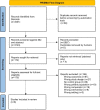Adverse perinatal outcomes after Roux-en-Y Gastric Bypass vs. Sleeve Gastrectomy: a systematic review
- PMID: 37532995
- PMCID: PMC10394842
- DOI: 10.1186/s12884-023-05515-7
Adverse perinatal outcomes after Roux-en-Y Gastric Bypass vs. Sleeve Gastrectomy: a systematic review
Abstract
Background: Pregnancies occurring after bariatric surgery are associated with various perinatal complications. However, there may be differences in the type of perinatal complications occurring after different methods of bariatric surgery. The aim of the current study was to compare adverse perinatal outcomes in pregnant women following Roux-en-Y Gastric Bypass (RYGB) vs. Sleeve Gastrectomy (SG).
Methods: A systematic database search was performed in PubMed, Embase, Scopus and CINAHL. Observational studies comparing perinatal outcomes post-bariatric (RYGB and SG) surgery to pregnancies without prior surgery were selected. Outcomes of interest were: maternal body mass index (BMI) at the time of conception, mode of delivery, time from surgery to conception, birth weight, gestational age and intrauterine fetal death. Article selection, risk of bias assessment and data extraction, were performed by two authors. The study protocol was published in its revised form in PROSPERO, registration number: CRD42021234480.
Results: A total of 3201 records were extracted. After duplicates were removed, 3143 records were screened for inclusion. Six studies fitted the selection criteria, of which four studies were RYGB and two SG (1100 post-RYGB vs. 209 post-SG). For the included studies, higher incidence of both SGA (22.9%, 11.9%, 14.2%) and LGA (4.2%, 4.8%, 1.7%) in SG compared to Roux-en-Y (SGA: 8.8%, 7.7%, 11.5%, 8.3% and LGA: 3.4%, 0.7%) were observed. SG had a shorter surgery to conception interval as compared to RYGB. Risk of bias assessment was moderate to serious for the studies included in the review, with bias in selection of participants being the major reason.
Conclusion: Our systematic review demonstrated no major differences in BMI, mode of delivery, birthweight, gestational age, or rates of intrauterine death between women having undergone RYGB vs. SG. The rate of SGA and LGA births were higher in the SG group, but this group also had a shorter surgery to conception interval. Future studies are indicated to counsel women of reproductive age on the most appropriate type of bariatric surgery that is associated with the best perinatal outcomes.
Keywords: Bariatric surgery; Gestational age; Intrauterine death.; Large for gestational age; Mode of birth; Perinatal outcomes; Roux-en-Y gastric bypass; Sleeve gastrectomy; Small for gestational age.
© 2023. The Author(s).
Conflict of interest statement
The authors declare no competing interests.
Figures
Comment in
-
Comment: pregnancy after bariatric surgery - achievements and open questions.BMC Pregnancy Childbirth. 2023 Aug 2;23(1):558. doi: 10.1186/s12884-023-05858-1. BMC Pregnancy Childbirth. 2023. PMID: 37533032 Free PMC article.
References
-
- Organization WH, World Health Organization: World Health Organization. Obesity and Overweight [Internet]. 2020 [updated 2020, April 1; cited 2021 May 3rd]. Available from:
-
- Committee PE, Bariatric Surgery Procedures. The American Society for Metabolic and Bariatric Surgery (ASMBS). The American Society for Metabolic and Bariatric Surgery (ASMBS); 2021 [updated 2021, May; cited 2021 May]. Available from: https://asmbs.org/patients/bariatric-surgery-procedures.
Publication types
MeSH terms
Grants and funding
LinkOut - more resources
Full Text Sources
Medical
Research Materials


